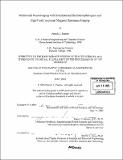Multimodal neuroimaging with simultaneous electroencephalogram and high-field functional magnetic resonance imaging
Author(s)
Purdon, Patrick L. (Patrick Lee), 1974-
DownloadFull printable version (22.51Mb)
Alternative title
Multimodal neuroimaging with simultaneous EEG and high-field fMRI
Other Contributors
Harvard University--MIT Division of Health Sciences and Technology.
Advisor
Emery N. Brown.
Terms of use
Metadata
Show full item recordAbstract
Simultaneous recording of electroencephalogram (EEG) and functional magnetic resonance imaging (tMRI) is an important emerging tool in functional neuroimaging with the potential to reveal new mechanisms for brain function by combining the high spatial resolution of fMRI with the high temporal resolution of EEG. Applications for this technique include studies of sleep, epilepsy, and anesthesia, as well as basic sensory, perceptual, and cognitive processes. Unlike methods that combine these modalities from separate recordings, simultaneous recordings can reveal temporal correlations between EEG and fMRI. Simultaneous recordings also eliminate environmental confounds inherent with separate recordings. MRI systems produce electromagnetic interference that can corrupt sensitive electrophysiological recordings, making simultaneous recordings challenging. Gradient switching and RF pulses can saturate EEG amplifiers, and cardiac pulsation within the static magnetic field produces large artifact signals ("ballistocardiogram") that confound EEG analysis. In this Ph.D. thesis, we develop an EEG acquisition system compatible with fMRI at 3 and 7 Tesla, a method for eliminating the ballistocardiogram artifact using adaptive filtering, and use these methods to study the 40-Hz auditory steady-state response (ASSR). The adaptive filtering method outperforms existing standard methods by up to 600%. The ASSR is a sub-microvolt level auditory evoked potential related to sleep, consciousness, and anesthesia. (cont.) Simultaneous recordings of ASSR and fMRI reveal that spontaneous fluctuations in the amplitude of the ASSR are represented throughout the auditory system, from cortex to brainstem, suggesting that brainstem structures play an important role in generating the 40-Hz ASSR and that integration of sensory information across multiple hierarchical scales, including the earliest portions of the central nervous system, may constitute an important component of awareness or arousal.
Description
Thesis (Ph. D.)--Harvard-MIT Division of Health Sciences and Technology, 2005. Includes bibliographical references.
Date issued
2005Department
Harvard University--MIT Division of Health Sciences and TechnologyPublisher
Massachusetts Institute of Technology
Keywords
Harvard University--MIT Division of Health Sciences and Technology.